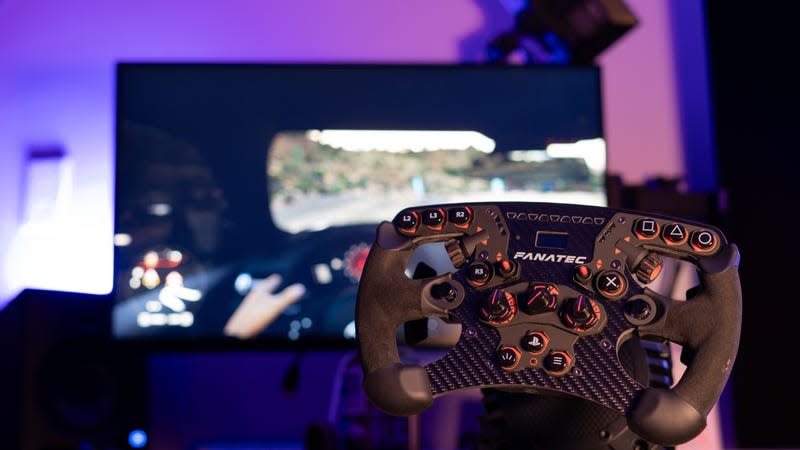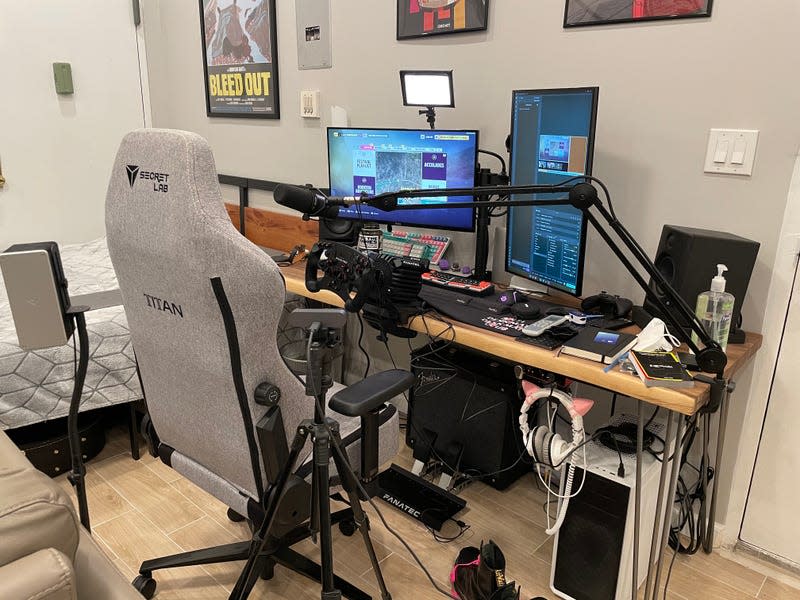Fanatec CSL: If It's Worth Doing, It's Worth Doing Right

I’m a fairly serious Forza Horizon player, if such a thing exists. I build and tune cars to exacting standards and I’m in the top 0.13% of players in the game’s competitive Rivals mode. So when Fanatec offered me a CSL wheel and pedals to test, I jumped at the opportunity — this was it, I thought, the chance to move up those rankings into (Bernie Sanders voice) the top one percent of the top one percent.
So why, after months of practice, have I not improved? Race after race, lap after lap, I’m still slower with the highly specialized Fanatec setup than with my little Xbox controller from Target. Incredibly, the answer seems to come down to one simple component: The brake pedal.
Read more
Full Disclosure: Fanatec offered me a wheel and pedals back when Twitchlopnik was just getting started. The setup made its fair share of appearances on stream, back when we were doing those. RIP.

Now I’ll admit: My home setup is far from professional. I don’t have a sim racing seat, there’s nothing preventing my s1ck g4m3r ch41r from rolling away from the pedals, and the whole mounting setup for the wheel is oddly rickety with my desk’s wavy front edge. I even had to dial the force feedback on the Fanatec base down for fear of the structural integrity of my monitor mounts. It’s not perfect.
But it’s enough, enough to get a sense for what works and what doesn’t when translating the experience of driving a car to the virtual world. Out of my three points of contact — the wheel and two pedals — two were more than up to the task. But the brake pedal, that single point of failure, always led me astray.
Where the pedal falls short is exactly where the steering base proved too strong for my dinky little setup: Feedback. With the wheel, feedback is incredible — all its precise, direct-drive glory informing me exactly where my virtual front wheels are. But with the brakes, there’s no real sense of pressure. It’s hard to modulate, hard to tell when you’ve asked too much from the front tires and begun to slide.
I found myself either overcooking corners, diving in too hard and braking too late, or approaching too cautiously and costing myself seconds. It’s an inherent flaw of the design, a potentiometer on a spring won’t ever have the kind of pulsing resistance that a hydraulic system has. Controllers emulate it well, with varied vibrations through the triggers to inform you when to lay off, but the pedals simply can’t. At least, this pedal simply can’t.
If you’ve ever looked into serious sim racing setups, you’ve likely heard of something called a “load cell” — a piece of hardware that actually does replicate that kind of hydraulic feedback. What’s more, Fanatec offers them in three-pedal setups all the time: Two standard pedals, for gas and clutch, and one with a load cell for braking.
If you’re truly serious about lap times, the load cell is worth the added cost. It’s certainly not cheap — a basic load cell pedal box will cost more than double the going rate for my two-pedal setup — but it offers the level of feedback needed to actually help you improve. The entire point of a sim setup is to allow you the precision that a real car does, rather than forcing you to settle for an analog stick and two triggers — why not get the most precise option you can?
Of course, some folks will disagree. I talked this over with Jalopnik’s resident sim racing expert Ryan Erik King, who effectively said — in much nicer words — that it was a skill issue: He doesn’t have a load cell pedal, and his sim racing has gone perfectly fine. We eventually determined that my choice in vehicle made the distinction matter more, with me eschewing his preferred purpose-built, high-downforce single seaters in favor of narrow-tired Acuras from the ‘90s, but the fact remains that Ryan doesn’t need that braking feedback to get an ideal lap time. I, apparently, do.
If you do, too, then skip the entry level of Fanatec’s lineup. The CSL wheel base is fantastic, but upgrade your pedals to a setup with a load cell. You’re already dropping beaucoup bucks on your setup, your wallet likely won’t notice the additional hit — but your feet, and your lap times, will.
More from Jalopnik
Sign up for Jalopnik's Newsletter. For the latest news, Facebook, Twitter and Instagram.

 Yahoo Autos
Yahoo Autos 